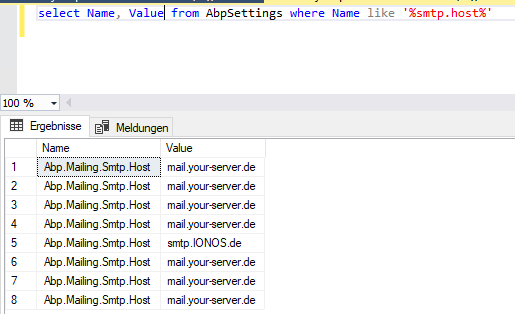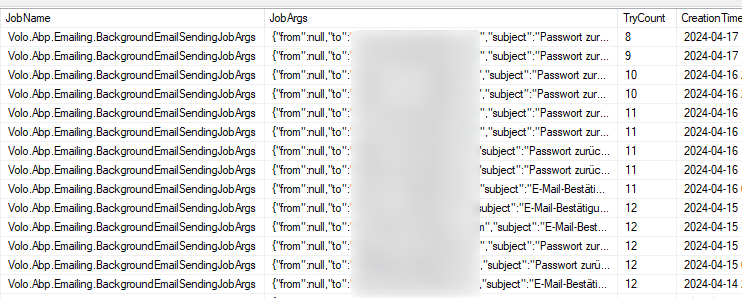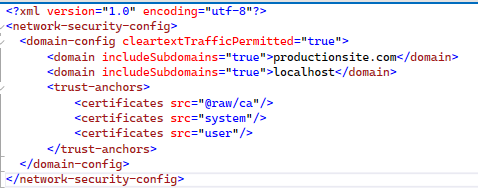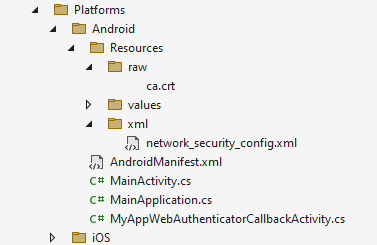Activities of "cbogner85"
Yes, now it works! Thank you very much for your blazing-fast replies!
Hi maliming,
thank you!
Unfortunately, this doesn't work... if I create my own class MyBackgroundEmailSendingJobArgs, jobs fail because of the different name:
Undefined background job for the job name: MyProject.Extensions.MyBackgroundEmailSendingJobArgs
Also tried to create a BackgroundEmailSendingJobArgs in the same namespace (Volo.Abp.Emailing) , then jobs are recognized from the worker, but tenant is null again and it uses hosts email settings, although I set in my QueueAsync :(
public async override Task QueueAsync(string to, string subject, string body, bool isBodyHtml = true, AdditionalEmailSendingArgs additionalEmailSendingArgs = null)
{
if (!BackgroundJobManager.IsAvailable())
{
await SendAsync(to, subject, body, isBodyHtml, additionalEmailSendingArgs);
return;
}
await BackgroundJobManager.EnqueueAsync(
new BackgroundEmailSendingJobArgs
{
TenantId = CurrentTenant.Id,
To = to,
Subject = subject,
Body = body,
IsBodyHtml = isBodyHtml,
AdditionalEmailSendingArgs = additionalEmailSendingArgs
}
);
}
Anything I can do or do I have to wait for the next minor release? It's some kind of critical as people can't activate their accounts if email confirmation is required and we receive many support tickets from people who can't reset their passwords.
Thanks, that worked!
Now the following error is logged:
Setting value for 'Abp.Mailing.Smtp.UserName' is null or empty!
Of course, it is not empty for any tenant. Therefore I also logged the current tenant id and found out that it's empty, too... so email settings are retrieved from the host instead of the current tenant. Since I need different email settings for tenants, I can't just define email settings on the host to make it working again.
I further investigated ABP's source code. Mails are queued in AccountEmailer.cs, I extended it as well and logged the current tenant inside SendPasswortResetLinkAsync. Tenant id is correctly logged, and also in SmtpEmailSender's QueueAsync. But in SendAsync it is lost. It seems that the problem is in BackgroundJobManager. Maybe this is a bug?
Hi maliming,
thanks for the hint. I'd like to try that, but I don't manage to override SmtpEmailSender. I tried the following:
[Dependency(ReplaceServices = true)]
[ExposeServices(typeof(ISmtpEmailSender), typeof(SmtpEmailSender), typeof(EmailSenderBase), typeof(CustomSmtpEmailSender))]
public class CustomSmtpEmailSender : SmtpEmailSender
{
protected IAuditingManager AuditingManager { get; set; }
public CustomSmtpEmailSender(ISmtpEmailSenderConfiguration smtpConfiguration, IBackgroundJobManager backgroundJobManager, IAuditingManager auditingManager) : base(smtpConfiguration, backgroundJobManager)
{
AuditingManager = auditingManager;
}
private async Task LogData()
{
using (var auditingScope = AuditingManager.BeginScope())
{
string username = await SmtpConfiguration.GetUserNameAsync();
string password = await SmtpConfiguration.GetPasswordAsync();
if (string.IsNullOrEmpty(password))
{
password = "empty";
}
else
{
password = "hidden";
}
string host = await SmtpConfiguration.GetHostAsync();
int port = await SmtpConfiguration.GetPortAsync();
AuditingManager.Current.Log.Comments.Add(string.Format("Emailsettings: SMTP: {0}, Port:{1}, Username: {2}, Password: {3}", host, port, username, password));
await auditingScope.SaveAsync();
}
}
protected async override Task SendEmailAsync(MailMessage mail)
{
await LogData();
await base.SendEmailAsync(mail);
}
public async override Task SendAsync(MailMessage mail, bool normalize = true)
{
await LogData();
await base.SendAsync(mail, normalize);
}
public async override Task SendAsync(string from, string to, string subject, string body, bool isBodyHtml = true, AdditionalEmailSendingArgs additionalEmailSendingArgs = null)
{
await LogData();
await base.SendAsync(from, to, subject, body, isBodyHtml, additionalEmailSendingArgs);
}
public async override Task SendAsync(string to, string subject, string body, bool isBodyHtml = true, AdditionalEmailSendingArgs additionalEmailSendingArgs = null)
{
await LogData();
await base.SendAsync(to, subject, body, isBodyHtml, additionalEmailSendingArgs);
}
}
But no data is logged, I also tried to set breakpoints and found out that none of the overriden methods are reached when sending mails. What am I doing wrong? I have overriden other ABP services in the past using the same way and it worked.
(Also tried to replace the service in WebModule using context.Services.Replace(ServiceDescriptor.Transient<SmtpEmailSender, CustomSmtpEmailSender>()); but didn't work either).
Thanks for you support!
Hi maliming,
thanks for you quick response. I already did that, no Strato SMTP settings were stored there:
Restarted the server again last night, now it seems the cache (?) was refreshed, however, it still doesn't work. Now I get the following error:
[ERR] Failure sending mail.
System.Net.Mail.SmtpException: Failure sending mail.
---> System.Net.Sockets.SocketException (10061): A connection could not be established because the target computer refused to connect.
at System.Net.Sockets.Socket.AwaitableSocketAsyncEventArgs.ThrowException(SocketError error, CancellationToken cancellationToken)
at System.Net.Sockets.Socket.AwaitableSocketAsyncEventArgs.System.Threading.Tasks.Sources.IValueTaskSource.GetResult(Int16 token)
at System.Threading.Tasks.ValueTask.ValueTaskSourceAsTask.<>c.<.cctor>b__4_0(Object state)
--- End of stack trace from previous location ---
at System.Threading.Tasks.TaskToAsyncResult.End(IAsyncResult asyncResult)
at System.Net.Sockets.TcpClient.EndConnect(IAsyncResult asyncResult)
at System.Net.Mail.SmtpConnection.ConnectAndHandshakeAsyncResult.InitializeConnectionCallback(IAsyncResult result)
--- End of stack trace from previous location ---
at System.Net.Mail.SmtpClient.ConnectCallback(IAsyncResult result)
--- End of inner exception stack trace ---
at Volo.Abp.Emailing.Smtp.SmtpEmailSender.SendEmailAsync(MailMessage mail)
at Volo.Abp.Emailing.EmailSenderBase.SendAsync(MailMessage mail, Boolean normalize)
at Volo.Abp.Emailing.EmailSenderBase.SendAsync(String to, String subject, String body, Boolean isBodyHtml, AdditionalEmailSendingArgs additionalEmailSendingArgs)
at Volo.Abp.Emailing.BackgroundEmailSendingJob.ExecuteAsync(BackgroundEmailSendingJobArgs args)
at Volo.Abp.BackgroundJobs.BackgroundJobExecuter.ExecuteAsync(JobExecutionContext context)
However, sending a test mail from email setting dialog works (as all other emails sent from my own code work, too).
Did you see contents of AbpBackgroundJobs I posted above? Is it normal that "from" is null?
- ABP Framework version: v8.0.5
- UI Type: MVC
- Database System: EF Core (SQL Server)
- Tiered (for MVC) or Auth Server Separated (for Angular): no
Hello,
we recently updated from ABP 7.3 to 8.0.5.
Since the update, the system no longer sends email confirmation and forgot password emails. Our system sends other status emails, which work. I noticed that under Tenants -> Setting Management there is now an option to "Allow changing email settings" and suspected that as the cause. After activation, I was able to update email settings within the tenants, but this didn't make any changes.
I can see that the AbpBackgroundJobs table is overflowing with failed email jobs:
Inside the application logfile, I see the following error:
Mailbox unavailable. The server response was: 5.7.0 The sender address used in the Mail From does not belong to your authenticated STRATO package.
Strangely, we no longer use Strato email addresses at all. We were using Strato, but switched about 2 years ago and of course changed the SMTP settings - it always worked and the other system emails also work.
I can't find definitions for Strato SMTP server anywhere - neither in the tenants' email settings nor in the database tables (AbpSettings, AbpSettingDefinitions).
Apparently there are some very old email settings cached somewhere, but I can't find out where. We don't use Redis and I have already tried restarting the server. There are also no email settings stored in the appsettings.json.
Additional information: We have a central login page for all tenants and therefore I have overwritten some ABP methods (LoginModel, ResetPasswordModel, SendSecurityCodeModel etc.) by simply deactivating the TenantFilter, searching for the user using the email address (a user cannot exist in multiple tenants) and setting the current tenant based on the user (CurrentTenant.Change(user.tenantId)). But I don't think this has anything to do with the problem, since - as written above - Strato's SMTP server addresses are not stored anywhere.
What is happening here?
Thanks in advance.
PS: In my development environment everthing works as expected.
Hi liangshiwei,
thanks for your reply. I can't believe I overlooked that (as I mentioned before, it must have been something completely obvious).
As far as I unterstood, certificate validation shouldn't be disabled as it makes the app vulnerable to man in the middle attacks. However, this helps as I can see the detailed error now (SslPolicyErrors.RemoteCertificateChainErrors) and hopefully I'll find out how to make Android accept our certificates before going live. And in the meantime, I can test my app on production with the certifcate validation disabled.
Thanks!
To add some details what I've already tried: I found out that Android doesn't accept all certificate authorities. Therefore, I added the intermediate certificate to Platforms/Android/Resources/raw and modified network_security_config.xml as described here and here. (Actually my application isn't certified from Let's Encrypt but rather ZeroSSL, as I had to switch for some reason, but certificates are generated using Certify the Web). I also tried to add my certificate and the whole chain, nothing worked out...
This is what network_security_config.xml looks like:
(of course, productionsite.com is actually replaced with the URL of my production environment)
This is the folder structure:
Also, network_security_config.xml seems to be correctly attached to AndroidManifest.xml
I also tried to manually install the root and intermediate authorities to the emulator, didn't work either.
I have no idea what I'm doing wrong...
PS: Out of curiosity, I tried to set RemoteServices > Default > BaseUrl to microsoft.com (and added microsoft.com to allowed domains in network_security_config.xml). Even then the certificate rejection occurs. Therefore I suspect it's not really a problem with the authority, but something inside MAUI that rejects just every outgoing connection/ certificate.
- ABP Framework version: v8.0.5
- UI Type: MVC /
- Database System: EF Core (SQL Server)
- Tiered (for MVC) or Auth Server Separated (for Angular): no
Hello,
I developed a MAUI app, on my development machine everything runs fine, but when I try to connect the production server from the MAUI app on Android, it crashes while trying to connect to RemoteService/ OIDC:
Java.Security.Cert.CertificateException The remote certificate was rejected by the provided RemoteCertificateValidationCallback.
My production server has a valid certificate from Let's encrypt. Also, I can open https://productionsite/.wellknown/openid-configuration and it also shows a valid certificate (even on the Android device's/ emulator's browser), but the MAUI app rejects the certificate.
I can even reproduce the behavior by creating a blank ABP project with MAUI enabled and trying to run it locally using ngrok. As long as MAUI connects to localhost, it works. But when I change RemoteService > Default > BaseUrl or Oidc > Options > Authority in MAUIs appsettings.json to ngrok URL, the same certification rejecting error occurs.
I'm completely lost... struggling for a week now, having read abp.io documentation and hundreds of forum entries, but nothing worked out. Probably I'm missing something completely stupid and trivial, but I can't find the solution... Please point me in the right direction!!
Thanks
Hi @ensin,
thanks for your reply!
Both approaches work almost as expected, except for the fact that, because of disabling JS style loading, switching themes doesn't work properly - nothing happens after clicking on a theme name.
I worked around this by adding onclick="location.reload()" to the menu items:
Is there a better solution?
Thanks in advance and best regards




